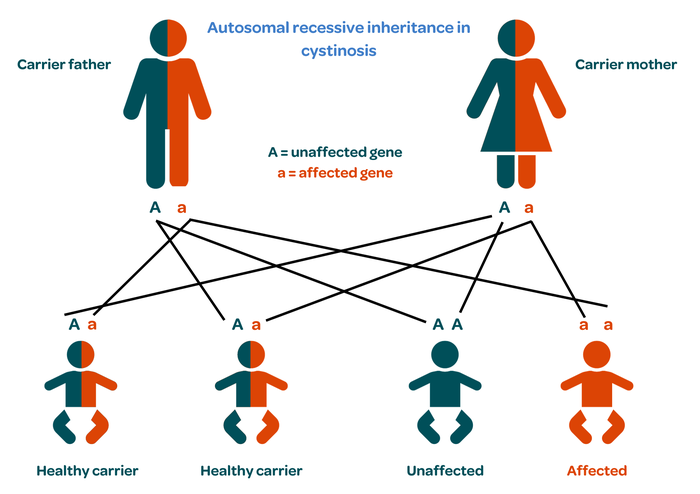What is cystinosis?
Cystinosis (also known as nephropathic cystinosis) is a rare inherited condition that affects the kidneys and eyes. It is caused by a build-up in the body of an amino acid called cystine. This causes the kidneys to leak essential salt, water and potassium, which can eventually lead to kidney failure and the need for dialysis or transplant.
Cystinosis affects around 1 in 200,000 people in the UK. Two or three new cases are diagnosed each year. It is usually first diagnosed before the age of two. Men and women are affected equally.
Note: Cystinosis is a different condition to cystinuria.
What are the signs and symptoms of cystinosis?
The first signs of cystinosis usually start before the age of 18 months. Common symptoms of cystinosis in children include:
- difficulty feeding
- increased thirst
- slow growth
- muscle weakness
- rickets (softening of the bones)
- dehydration and/or fever
Complications may develop in adults with cystinosis due to the long-term build-up of cystine. These can include:
- increased risk of developing diabetes
- muscle weakness
- thyroid problems
- weak bones
What causes cystinosis?
Cystinosis is caused by a problem with the body’s transport of the amino acid cystine. Cystine is normally broken down in part of the body’s cell called the lysosome and then released into the rest of the cell. In cystinosis, a fault in the gene responsible for this process means that the cystine remains trapped in the lysosome where it can build up and form crystals. These build-ups are more likely to occur in the tiny filters of the kidneys (tubules) and in the eyes.
How is cystinosis diagnosed?
Cystinosis is usually diagnosed in early childhood by a blood test which shows high levels of cystine in the white blood cells. A urine test will also show high levels of protein and electrolytes.
Genetic testing may be offered if there is a history of the condition.
Does cystinosis affect other parts of the body?
As well as the kidneys, cystinosis also causes tiny cystine crystals to form in the eyes. These can be seen by using a slit lamp where a thin strip of light is shone into the eye. The crystals do not affect the vision but can cause intense sensitivity to bright light. People with cystinosis often have to wear dark glasses when outside, regardless of the weather.
Does cystinosis run in families?
Cystinosis is an inherited condition so it can run in families. It is caused by a change or mutation in a gene called CTNS. It is inherited when both parents pass on a copy of the faulty gene.
Everybody has two copies of the CTNS gene, one from each parent.
Healthy people have two normal copies.
Carriers have one copy that works normally and one that doesn’t. Carriers are usually healthy because the normal copy can still do its job. However, they can still pass cystinosis on to their child.
In people with cystinosis, neither copy of the gene works properly.
When both parents are carriers, a child could be healthy with two normal genes, a healthy carrier like their parents with one healthy and one faulty gene or affected with both genes being faulty. This pattern is called autosomal recessive inheritance.

How is cystinosis treated?
The earlier that cystinosis is diagnosed and treatment begins, the better the outcome. The main treatment is a medication called cysteamine which controls the build-up of cystine. It can be hard to swallow as a capsule as it has an unpleasant sulphur smell (like rotting eggs). Granules may be prescribed instead, which can be mixed with applesauce or fruit juice to hide the taste.
Cysteamine eye drops can also be used to help with light sensitivity.
Nutritional supplements and/or growth hormones are often prescribed for young children to make up for the loss of salts and minerals.
Cystinosis progresses slowly. Without treatment, kidney failure is likely to occur in about 10 years. Taking medication exactly as prescribed drastically improves outcomes and significantly delays the need for dialysis or transplant.
If a transplant is eventually needed, cystinosis will not reoccur in the new kidney.
Where can I get more information or support about cystinosis?
For more information on cystinosis, including its genetics, diagnosis, symptoms and treatment, visit Cystinosis Foundation UK.

Publication date: 11/2023
Review date: 11/2026
This resource was produced according to PIF TICK standards. PIF TICK is the UK’s only assessed quality mark for print and online health and care information. Kidney Care UK is PIF TICK accredited.